Bruker Ringing Mode for Surface Adhesion Property Mapping with AFM
Ringing Mode is a new Bruker AFM mode for enhanced surface adhesion property mapping. It delivers 8 new quantitative compositional imaging channels.
Ringing Mode gives unique, new insights into processes such as polymer necking or the distribution and length of surface coating molecules.
Blue Scientific is the official distributor for Bruker AFM in Norway, Sweden, Denmark, Finland and Iceland. For more information or quotes, please get in touch.
Bruker AFM instruments
Articles about AFM
Contact us on +44 (0)1223 422 269 or info@blue-scientific.com
Ringing Mode
Ringing Mode is a new Bruker AFM mode that records up to 8 new quantitative compositional imaging channels simultaneously in a single scan.
- Map surface adhesion properties of materials at the nanoscale.
- Acquire previously inaccessible information.
- New data channels from the ringing portion of the peak force feedback signal.
- Integrates seamlessly with Bruker AFM systems.
Integrated together in a single AFM mode, Ringing Mode and PeakForce QNM (Quantitative Nanomechanics) provide an enhanced, comprehensive solution for nanoscale characterisation.
8 New Data Channels
Ringing Mode uses the ringing signal resulting from surface detachment of the AFM probe, a rich signal that hasn’t previously been exploited. This offers new insights into the often complex unbinding process of surface molecules.
The new mode brings you 8 new quantitative compositional imaging channels, for enhanced adhesion property information that’s complementary to mechanical and structural data:
- Restored Adhesion
- Adhesion Height
- Zero-Force Height
- Disconnection Height
- Pull-Off Neck Size
- Disconnection Distance
- Disconnection Energy Loss
- Dynamic Creep Phase Shift
Together with PeakForce QNM, this provides a total of up to 14 different data types, including the standard nanomechanical property channels.
Pull-Off Neck Size
Pull-Off Neck Size measures the maximum height of the neck pulled from the surface of soft matter during probe retraction. This gives you nanoscale insights into processes such as:
- Polymer necking
- Membrane tubule formation in cells
- Tensile deformation of surface layers
- … and more.
In the example below of a human melanoma cell, each of the four data channels yields independent information. This illustrates the rich data available. All channels were obtained simultaneously.
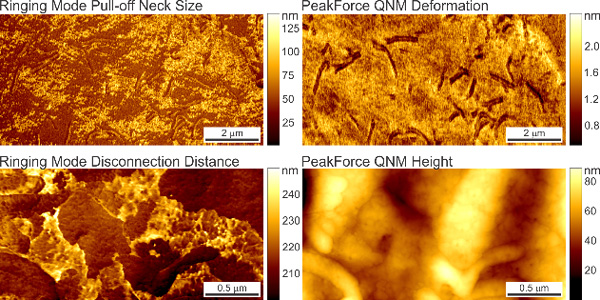
Disconnection Distance
This channel measures the extension length of molecules stretched from the surface by the AFM probe. It can be used to examine surface molecules on polymer coatings and cell membranes. These nanoscale maps provide key information about the distribution and organisation of soft, flexible molecules that can be difficult to visualise using other techniques.
The example below of a polymer sample shows the difference between Pull-off Neck Size and Disconnection Distance data channels. The Disconnection Distance includes the length of both the neck and any remaining surface molecules.
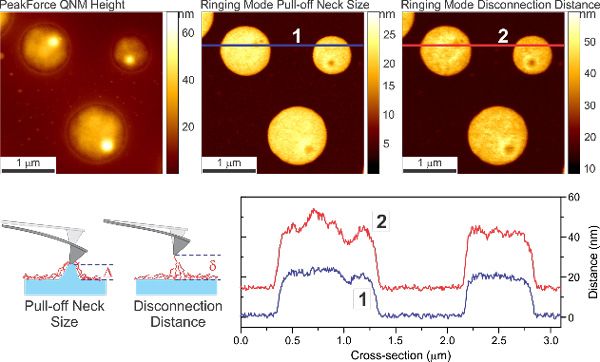
Disconnection Energy Loss
When the AFM probe interacts with the sample surface, energy is dissipated in three categories:
- Adhesion energy.
- Energy loss due to the viscous response of the sample during contact deformation.
- Disconnection energy loss.
While PeakForce QNM measures the total energy loss, Ringing Mode measures Disconnection Energy Loss separately. This is closely associated with molecules on the surface layer rather than the bulk sample material.

Restored Adhesion
Typically, adhesion measurements take into account the overall tip-sample detachment (pull-off force). This new channel focuses solely on the detachment of residual surface molecules or molecular tails, after the AFM tip has lost adhesive contact with the sample surface.
The example below shows Ringing Mode + PeakForce QNM images acquired simultaneously from a PS/LDPE polymer sample. The adhesion data clearly shows that LPDE has stronger adhesive interactions than PS. The Restored Adhesion data enriches this information, showing that the surface layer of LDPE is more heterogeneous and disconnection of the residual surface molecules from the tip is more dissipative.

Instrumentation
Ringing Mode is available with these Bruker AFM systems:
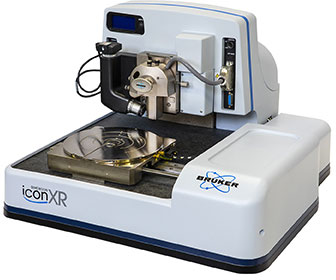
Bruker Dimension XR
- Scanning Probe Microscope
- Models optimised for nanomechanics, nanoelectrical AFM and nanoelectrochemistry.
- Exclusive DataCube nanoelectrical modes.
- AFM-nDMA mode for polymer nanomechanics that correlates with bulk dynamic mechanical analysis.
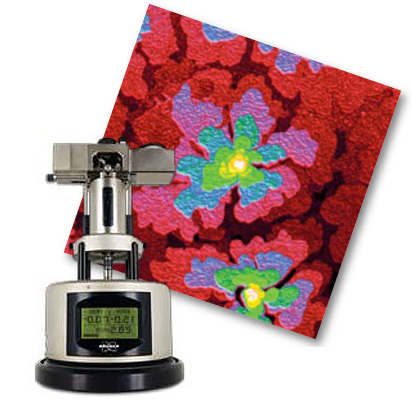
Bruker MultiMode 8-HR
- High resolution AFM.
- 6x faster imaging in air than most conventional AFMs.
- Easy to achieve high quality results.
- Versatile: image in air, fluid and a variety of temperatures.
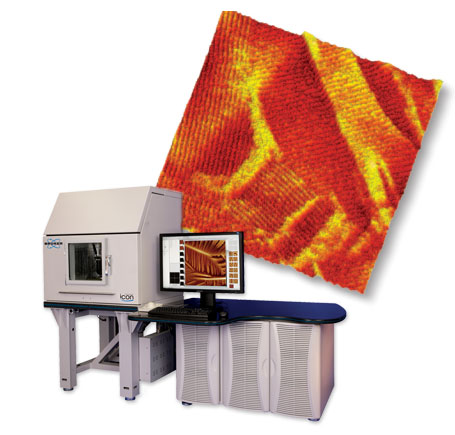
Bruker Dimension Icon
- Large sample AFM.
- Highest performance on any AFM sample.
- Quantitative nanoscale material property mapping.
- Simultaneous nanoscale imaging and nanomechanical analysis.
More Information
Blue Scientific is the official distributor of Bruker AFM in Scandinavia and the Nordic region. We’re available to provide quotes and answer all your questions – just get in touch:


